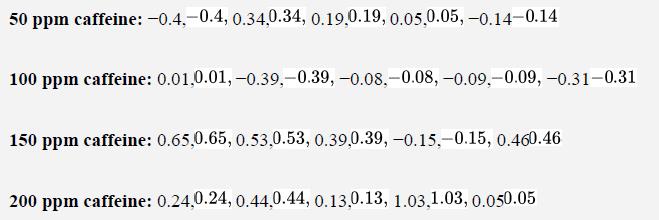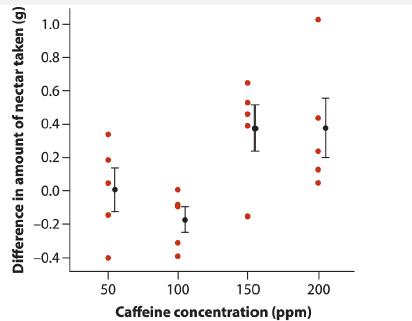Calculation practice: Analysis of variance. Many humans like the effect of caffeine, but it occurs in plants
Question:
Calculation practice: Analysis of variance. Many humans like the effect of caffeine, but it occurs in plants as a deterrent to herbivory by animals. Caffeine is also found in flower nectar, and nectar is meant as a reward for pollinators, not a deterrent. How does caffeine in nectar affect visitation by pollinators? Singaravelan et al. (2005) set up feeding stations where bees were offered a choice between a control solution with 20% sucrose or a caffeinated solution with 20% sucrose plus some quantity of caffeine. Over the course of the experiment, four different concentrations of caffeine were provided: 50, 100, 150, and 200 ppm. The response variable was the difference between the amount of nectar consumed from the caffeine feeders and that removed from the control feeders at the same station (in grams). Here are the data and strip chart, including standard error bars:


Does the mean amount of nectar taken depend on the concentration of caffeine in the nectar? We will carry out an analysis of variance to find out.
a. State the null and alternate hypotheses appropriate for this question.
b. Calculate the following summary statistics for each group (i.e., for each caffeine treatment): ni , Y¯i, and si.
c. Set up an ANOVA table to keep track of your results. Add to this table through the remaining steps.
d. What is the mean square error MSerror ?
e. How many degrees of freedom are associated with error?
f. Calculate the estimate of the grand mean.
g. Calculate the group sum of squares.
h. Calculate the group degrees of freedom and the group mean square.
i. What is FF for this example?
j. Use Statistical Table D (or a computer) to find the P-value for this test.
Step by Step Answer:

The Analysis Of Biological Data
ISBN: 9781319226237
3rd Edition
Authors: Michael C. Whitlock, Dolph Schluter





